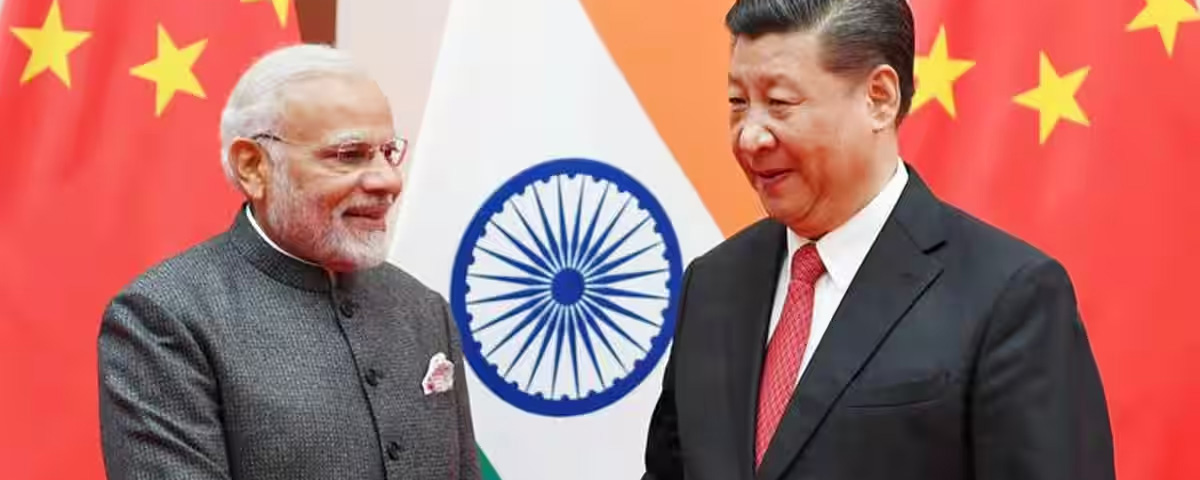Balancing the Dragon: India’s Strategic Tightrope


In August 2025, Indian Prime Minister Narendra Modi traveled to Tianjin to participate in the Shanghai Cooperation Organization (SCO) summit. This marked Modi’s first visit to China since the 2020 Galwan Valley clash, which resulted in fatalities and a prolonged military standoff. The meeting with Chinese President Xi Jinping and Russian President Vladimir Putin attracted international attention, with some analysts suggesting that India had been nudged closer to China due to U.S. tariffs and diplomatic pressures.
However, this interpretation oversimplifies the situation. India’s engagement with China is not a reactionary pivot; it is part of a sustained effort to stabilize relations while maintaining strategic autonomy. The thaw began during the 2024 BRICS summit in Kazan, Russia, where Modi and Xi conducted substantive bilateral discussions for the first time since 2019. These talks led to a formal agreement on troop disengagement along the Line of Actual Control (LAC), easing tensions in disputed areas such as Depsang and Demchok.
Economic Interdependence Amid Political Rivalry
Trade between India and China remains substantial, with bilateral exchanges exceeding $100 billion annually. Despite political tensions, economic interdependence continues to shape the relationship. China remains India’s largest trading partner, yet the trade balance heavily favors China, prompting India to explore diversification and address structural imbalances.
Concurrently, India is facing challenges in trade with the United States. In August 2025, the Trump administration imposed a 50% tariff on Indian imports, citing India’s continued procurement of Russian oil as a major concern. This move, perceived as coercive by Indian policymakers, has underscored the need for a recalibrated approach toward both Western and Asian powers.
India’s economic strategy involves strengthening trade with China cautiously while simultaneously expanding partnerships elsewhere. For instance, India is increasingly engaging with ASEAN, the EU, Japan, and Australia to diversify supply chains and reduce overreliance on any single partner.
Strategic Autonomy as the Guiding Principle
India’s foreign policy philosophy emphasizes strategic autonomy—the ability to make independent decisions in a multipolar world without becoming overly dependent on any single global power. Engagement with China, in this context, is pragmatic rather than ideological.
While India seeks cooperation on economic and regional security issues, it remains vigilant about China’s assertiveness in border regions, the South China Sea, and through initiatives like the Belt and Road Initiative (BRI). Participation in multilateral forums such as the Quad (India, the U.S., Japan, Australia) reflects India’s commitment to a free and open Indo-Pacific, balancing China’s influence without direct confrontation.
Regional and Global Implications
The India-China dynamic is closely watched by other major powers. The U.S., for example, has historically supported India as a counterbalance to China’s growing influence. However, inconsistent policies—such as punitive tariffs against India while adopting a softer stance toward China—have prompted New Delhi to reconsider its strategic calculations.
At the same time, China faces economic slowdowns, pressure from Western markets, and scrutiny over its support for Russia. These factors make Beijing more receptive to dialogue and confidence-building measures with India. The mutual interest lies in maintaining regional stability, avoiding military escalation, and fostering economic growth in a highly competitive environment.
Beyond Borders: Economic and Security Calculations
For India, managing its relationship with China goes beyond borders; it is about long-term economic security and global positioning. India continues to invest in infrastructure, technology, and military modernization to enhance its leverage. Programs such as domestic manufacturing initiatives, renewable energy development, and strategic port expansions help India reduce vulnerabilities to external pressures.
Simultaneously, India continues to seek regional partnerships in trade and security. Its agreements with ASEAN, participation in regional security dialogues, and strategic outreach in the Indian Ocean aim to create a buffer against unilateral influence from China or any other power.
Pragmatic Engagement, Not Dependence
India’s engagement strategy underscores one principle: engagement does not equal dependence. While cooperation on trade, climate, and multilateral forums is beneficial, India avoids overreliance on China. This approach allows India to retain leverage in negotiations, protect its sovereignty, and mitigate potential coercive measures from global powers.
Moreover, India leverages multilateral platforms to balance China’s influence. BRICS, SCO, and G20 forums enable India to pursue regional cooperation while advancing its economic and strategic goals. By fostering dialogue, India maintains communication channels that reduce the risk of unintended conflicts and enhance predictability in bilateral relations.
Conclusion: Walking the Tightrope
India’s approach to China reflects a nuanced understanding of global geopolitics. The country balances engagement and deterrence, cooperation and competition. While economic ties and regional stability provide reasons for dialogue, national security and strategic autonomy remain non-negotiable.
In essence, India does not seek to become dependent on China. Instead, it pursues a pragmatic path of cautious engagement, leveraging diplomacy, trade, and multilateral forums to safeguard national interests while exploring mutually beneficial cooperation. As global dynamics continue to shift, India’s measured approach exemplifies strategic foresight, ensuring that it remains a decisive actor in Asia without compromising its independence.